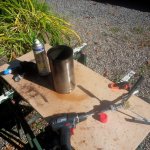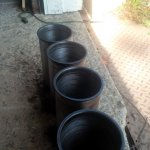merlot566jka
Member
- 360
- 0
- 16
- Location
- ID or TX or OK
Hey guys,
About to rebuild my engine, have all the parts in hand and have been studying the manual. Old versions for the lds-427 mentions honing the liners after install. Yet the newer manuals for the ldt and lds-465 do not mention honing. I pulled out one of the new liners from the box and they are not honed already. So, I assume, I need to hone them before putting pistons in.
I started looking at the dingle berry like hones, took me a while to find a correct size, and now I need to pick out what type of material and grit to use on the hone. It mentions using oem ring manufacture reccomendations based on the type of ring. So I have searched and searched, but I cannot find anything saying what kind of rings our engines have or what the recommendations are for honing. Does anyone know?
Also currious if anyone has had to use a hydraulic puller to remove the sleeves or if they just pop out after a few taps from the bottom? In the manual it shows the hydraulic tool to remove and install, but talking to people who have re-sleeved an engine, they say it take a little force and then it will pop right out with ease.
Thanks for any help and if anyone has pointers that they learned when they rebuilt theirs, I would love to hear it.
Oh, and these are the newer LDS sleeve kits with the 3 ring piston that is coated on top.
About to rebuild my engine, have all the parts in hand and have been studying the manual. Old versions for the lds-427 mentions honing the liners after install. Yet the newer manuals for the ldt and lds-465 do not mention honing. I pulled out one of the new liners from the box and they are not honed already. So, I assume, I need to hone them before putting pistons in.
I started looking at the dingle berry like hones, took me a while to find a correct size, and now I need to pick out what type of material and grit to use on the hone. It mentions using oem ring manufacture reccomendations based on the type of ring. So I have searched and searched, but I cannot find anything saying what kind of rings our engines have or what the recommendations are for honing. Does anyone know?
Also currious if anyone has had to use a hydraulic puller to remove the sleeves or if they just pop out after a few taps from the bottom? In the manual it shows the hydraulic tool to remove and install, but talking to people who have re-sleeved an engine, they say it take a little force and then it will pop right out with ease.
Thanks for any help and if anyone has pointers that they learned when they rebuilt theirs, I would love to hear it.
Oh, and these are the newer LDS sleeve kits with the 3 ring piston that is coated on top.



